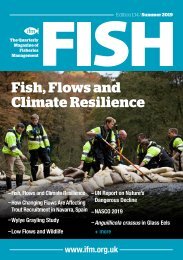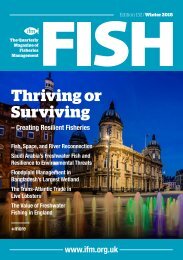FISH 133 Spring 2019
The members magazine from the Institute of Fisheries Management
The members magazine from the Institute of Fisheries Management
Create successful ePaper yourself
Turn your PDF publications into a flip-book with our unique Google optimized e-Paper software.
Climate Change and Freshwater Ecosystems<br />
What is climate change?<br />
‘A change in global or regional climate patterns,<br />
in particular a change apparent from the mid to<br />
late 20th century onwards and attributed largely<br />
to the increased levels of atmospheric carbon<br />
dioxide produced by the use of fossil fuels’.<br />
‘The climate change phenomenon refers to<br />
seasonal changes over a long period with respect<br />
to the growing accumulation of greenhouse<br />
gases in the atmosphere’.<br />
Two definitions of climate change but one refers<br />
only to carbon dioxide and in reality greenhouse<br />
gases can be water vapour, which acts as a<br />
feedback, carbon dioxide (minor but important),<br />
methane (less abundant but more active),<br />
nitrous oxide (often related to soil cultivation) and<br />
chlorofluorocarbons (industrial but regulated)<br />
Impacts on freshwater<br />
All very complicated and several studies show<br />
many different impacts, so the whole picture<br />
can be quite muddled. Needless to say that the<br />
impacts on freshwater can be very damaging.<br />
A study by Imperial College, London states<br />
that freshwater constitutes only 2.5% of the<br />
total global water stock and only 0.3% of this<br />
water is available in rivers and lakes. This is so<br />
much smaller than the marine water stock but<br />
freshwater is so important for biodiversity and<br />
ecosystem services crucial to humans. The use<br />
of freshwater for aquaculture is on the increase<br />
and this puts more pressure on the ecosystem<br />
but also raises the question of how sustainable it<br />
will be if temperatures rise.<br />
The World Wide Fund for Nature estimates<br />
in their Nature’s Living Planet index that from<br />
the 1970s there has been an 81% decline in<br />
freshwater species populations.<br />
The warming of rivers and lakes will have an<br />
effect on fish species, with cyprinid and percid<br />
fish becoming more dominant and salmonid<br />
species declining to a point where populations<br />
could collapse. This is especially so in shallow<br />
lakes where there is no thermal stratification. In<br />
Ireland, for example, Lough Neagh supports cold<br />
water species, often referred to as glacial relics,<br />
such as Atlantic salmon, Arctic charr and pollan<br />
that could be displaced by non-native species.<br />
In lakes, the higher temperatures will also bring<br />
about increased growth of phytoplankton and<br />
will accelerate growth causing higher levels of<br />
eutrophication. This could see a change in the<br />
distribution of sensitive species by migration<br />
to cooler locations and possibly extinction for<br />
others. Non-native species will probably extend<br />
their range of distribution and this includes fish,<br />
plants and invertebrates. In rivers, species will<br />
move to upstream areas and will upset the fine<br />
balance of species composition.<br />
Wetlands are particularly sensitive habitats<br />
and provide a home to a large range of aquatic<br />
and terrestrial species. Bogs and fens tend to<br />
be peat-based, and as such contribute to carbon<br />
dynamics. Any changes to temperature or<br />
nutrient levels, or in the quantity or quality<br />
of water supply will change the character of<br />
the habitat and this will not only affect<br />
species survival but will alter the benefits to<br />
human communities.<br />
One study carried out in Germany looked at the<br />
effect of carbon dioxide on water fleas. These<br />
are eaten by small fish, which are prey to larger<br />
fish and other species. Any changes to this food<br />
source could influence an entire lake ecosystem.<br />
The fleas can sense chemicals given off by<br />
fish and thereby avoid being preyed on.<br />
The study showed that high levels of carbon<br />
dioxide interfere with the nervous system of the<br />
fleas and blunt their ability to sense predators.<br />
Similarly a study of minnows, by University<br />
of Winnipeg, showed that fish swimming<br />
in water rich in carbon dioxide did not respond<br />
as quickly to alarm signals released by<br />
other minnows as in water with lower levels<br />
of carbon dioxide.<br />
Others issues relate to human health and the<br />
spread of disease-bearing insects, such as<br />
mosquitoes. A spokesperson from the British<br />
Pest Control Association, said: “In terms of the<br />
Asian tiger mosquito, it is particularly important<br />
that this pest does not get a toe-hold in the UK<br />
as it is a species of concern. They can transmit<br />
debilitating and even deadly viruses, including<br />
Chikungunya and Dengue fever.”<br />
There are yet other issues such as flooding and<br />
storms that are increasing and all these can have<br />
a deleterious effect on freshwater ecosystems.<br />
32





